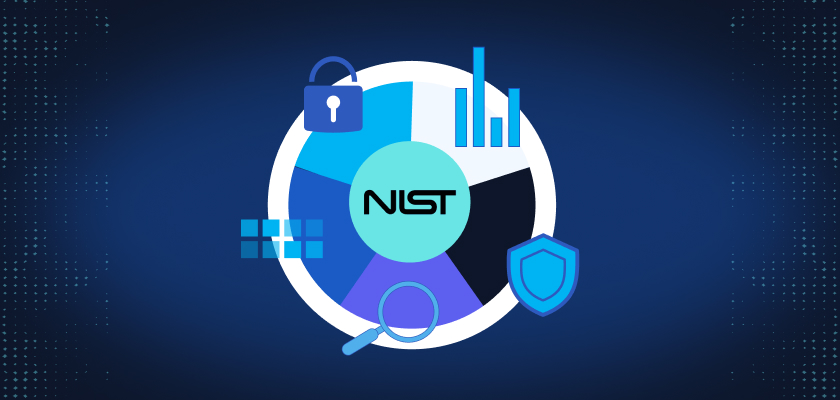
NIST compliance is a foundational step in building a robust cybersecurity framework, safeguarding sensitive data, and meeting regulatory requirements. This guide explains the key steps, best practices, and challenges organizations face in aligning with NIST standards, ensuring a secure and compliant IT environment.
What Is NIST Compliance?
NIST compliance involves adhering to the cybersecurity standards and guidelines established by the National Institute of Standards and Technology (NIST). These standards are designed to help organizations identify, mitigate, and manage cybersecurity risks effectively.
Achieving NIST compliance means implementing a proactive approach to data protection, ensuring that IT systems, processes, and controls align with industry best practices. Organizations across sectors—such as healthcare, defense, finance, and IT services—rely on NIST standards to secure sensitive information, build trust with stakeholders, and meet regulatory obligations.
By aligning with NIST standards like NIST SP 800-53, NIST 800-171, and NIST CSF, organizations can address emerging threats while maintaining compliance with frameworks such as CMMC, HIPAA, and PCI-DSS.
For example:
- NIST SP 800-53 offers comprehensive controls for federal agencies and contractors.
- NIST 800-171 provides guidelines for protecting Controlled Unclassified Information (CUI).
- NIST CSF offers a flexible, risk-based approach for organizations of all sizes.
How to Achieve NIST Compliance: Step-by-Step Guide
Achieving NIST compliance requires a structured approach tailored to an organization’s specific needs. Following these key steps ensures alignment with NIST standards and strengthens overall security:
| Step | Description | Key Actions |
| Define Scope and Objectives | Establish the systems, data, and processes that require compliance. | Identify critical IT assets and align security goals with business objectives. |
| Conduct a Risk Assessment (RA) | Evaluate the current security landscape and identify potential vulnerabilities. | Document risks, threats, and impacts; use tools like CVSS for scoring vulnerabilities. |
| Develop a System Security Plan (SSP) | Create a detailed plan outlining security policies, procedures, and configurations. | Reference NIST SP 800-53 to structure the SSP and address identified risks. |
| Implement Security Controls (PR) | Apply security measures to mitigate risks and protect sensitive systems. | Focus on access control (AC), data encryption (SC), and incident response (IR). |
| Perform a Gap Analysis | Compare current security practices with NIST requirements. | Identify deficiencies and develop a Plan of Action and Milestones (POAM) to address them. |
| Conduct Security Audits and Testing | Validate security implementations and identify weaknesses. | Perform internal audits, vulnerability scans, and penetration tests; address findings systematically. |
| Document Compliance Efforts | Maintain clear records of security implementations, risks, and remediation actions. | Use templates to organize evidence for audits and compliance reviews. |
| Continuous Monitoring and Improvement (DE) | Ensure ongoing compliance and adapt to new threats. | Regularly update policies, perform assessments, and monitor system activity. |
Best Practices for Achieving and Maintaining NIST Compliance
Organizations that excel in achieving NIST compliance follow key best practices to ensure sustained alignment with standards:
| Best Practice | Why It’s Important | Key Action |
| Automate Compliance Monitoring | Streamlines the compliance process and reduces manual effort. | Use tools like SIEMs, patch management platforms, and vulnerability scanners. |
| Conduct Regular Employee Training | Reduces risks from human error and strengthens overall cybersecurity awareness. | Implement ongoing training programs and phishing simulations. |
| Engage Cybersecurity Experts | Provides expertise in addressing complex compliance challenges. | Hire certified consultants or managed security service providers (MSSPs). |
| Create a Compliance Roadmap | Ensures structured progress toward achieving full compliance. | Set clear milestones, responsibilities, and timelines for implementation. |
| Stay Updated on NIST Standards | Maintains compliance as NIST standards evolve to address emerging threats. | Monitor updates to NIST SP 800-53 Rev 5 and NIST CSF 2.0. |
| Perform Internal Audits and Mock Assessments | Identifies gaps before external audits, reducing risks of compliance failures. | Schedule biannual reviews and use gap analysis tools to track progress. |
Challenges to Watch for When Pursuing NIST Compliance
Achieving NIST compliance can be complex, with several challenges to address:
- Incomplete Asset Inventory: Ensure all IT assets, endpoints, and cloud services are accounted for.
- Lack of Role Clarity: Clearly define responsibilities within the compliance team to avoid gaps in accountability.
- Outdated Policies: Regularly review and update policies to reflect new threats and technologies.
- Limited Budget or Resources: Allocate sufficient resources for tools, training, and expert consultations.
- Vendor Management Risks: Ensure that third-party vendors meet NIST standards to mitigate supply chain vulnerabilities.
Achieve Cybersecurity Excellence with NIST Compliance
Achieving NIST compliance is a critical step in securing sensitive IT systems, ensuring regulatory alignment, and maintaining trust with clients and stakeholders. By following structured steps, adopting best practices, and addressing challenges proactively, organizations can strengthen their cybersecurity frameworks and reduce risks.
Regular audits, employee training, and continuous monitoring are essential to maintaining compliance. Organizations that prioritize these efforts not only meet regulatory requirements but also build a resilient foundation for long-term success in an evolving threat landscape.
Step-by-Step Guide to NIST Compliance for Service Providers
Simplify NIST compliance with a step-by-step roadmap, actionable best practices, and tools to help your MSP or MSSP scale services efficiently and securely.
Frequently Asked Questions About NIST Compliance
NIST compliance involves aligning with cybersecurity standards to protect sensitive data and reduce risks.
Follow a structured approach: conduct a risk assessment, develop an SSP, implement controls, and perform audits.
Key steps include defining scope, conducting risk assessments, and implementing security controls.
Policies should be reviewed annually or after significant changes to systems or regulations.
Costs vary based on organization size, tools, and external resources, such as consultants or audit services.